Scene of Sivas Congress Population: 365,250
Old names: Megalopolis, Sebastea
Festival: 4 September (commemorating 1919 Sivas Congress)
Sivas is stranded in the middle of nowhere, inconveniently far east of Ankara on the road to Erzincan. Not suprisingly, then, it sees relatively few foreign visitors.
So why would anyone want to make the trek out here? Well, because it’s one of those quintessentially Turkish towns that has been little touched by tourism and where local shops still have an authentically Turkish feel to them. Not only that but it’s home to some magnificent Selçuk monuments too.
Must-see attractions: Çifte Minare Medrese, Gök Medrese, Bürüciye Medrese, Şifaiye Medrese, Sivas Congress building (İnkılap Müzesi), Archaeology Museum, Kangalağa Konağı
Backstory
This is a town with a venerable past stretching right back to the Hittites. Like seemingly everywhere in Central Anatolia, it eventually fell to the Romans who called it first Megalopolis (Big City) and then Sebastea which was slowly corrupted to Sivas.
The ensuing 700 years of Byzantine supremacy have vanished without a trace. Instead it was the rather confusing period when the Danışmends, Selçuks, Mongols, İlkhans and Eretnids took it in turns to gain the ascendancy that has most stamped its mark on the town.
Sivas’ modern history is horribly marred by an incident that took plane at the Madımak Hotel in 1993. A group of Alevi intellectuals had gathered to attend a festival when a mob descended and set the hotel on fire. In the melee 37 people were killed although Aziz Nesin, the Turkish translator of Salman Rushdie’s Satanic Verses and the likely prime target of the mob, managed to escape. Although over 100 people were charged and many of them imprisoned, few people thought that justice had been done. The hotel has since been turned into a cultural centre.
Around town
For those interested in Turkey’s founding father, Mustafa Kemal Atatürk, Sivas is particularly worth a pilgrimage, because this was one of the towns he visited in 1919 while rallying support for resistance to the foreign powers who had occupied parts of the country in the aftermath of the First World War.
Atatürk had travelled overland from Samsun via Amasya to Sivas, where, on 4 September 1919, he convened the Sivas Congress in the imposing 19th-century boy’s high school that now serves as the İnkılap Müzesi (Revolution Museum: closed Mondays); in a nice touch the upstairs rooms are left as they would have been in the days when it was a school. Of course back then there were no flashy conference rooms with oval desks and powerpoint set-ups. Instead the delegates sat behind what look like old-fashioned school desks on which their photographs are now displayed.
The outcome of their deliberations was the creation of the Society for the Defence of the Rights of Anatolia and Thrace, a stepping-stone on the road to renewed war and, ultimately, independence and the formation of the Republic of Turkey.
Time on your hands: Ulu Cami, Kale Cami, Güdük Minare, Subaşı Hanı, Sivas İhramcızade Cultural and Art Centre
The museum is just down the road from the Meydan adorned with a fountain that marks the centre of town. This is overlooked by a large three-storey Valilik (Governor’s Office) that was built in two parts in 1884 and 1913. Across the road is the equally impressive stone Gendarmerie building with models of policemen in the uniforms of the 1930s in its windows.
 Uphill behind the Valilik (take the road to the right of the Ögretmenler Parkı (Teachers Park)) is the Sivas Archaeological Museum (closed Mondays) housed in what started life as the Old Art School (1899 and 1911). Come here to see the finds from the Hittite site of Sarissa (Kuşaklı), near Ulaş. There’s also a fine Roman mosaic that was found in a village garden.
Uphill behind the Valilik (take the road to the right of the Ögretmenler Parkı (Teachers Park)) is the Sivas Archaeological Museum (closed Mondays) housed in what started life as the Old Art School (1899 and 1911). Come here to see the finds from the Hittite site of Sarissa (Kuşaklı), near Ulaş. There’s also a fine Roman mosaic that was found in a village garden.
In Selçuklu Parkı, the newly landscaped area across the road from the İnkılap Müzesi, stand the remains of several graceful medreses (theological schools). The oldest, the Şifaiye (Healing) Medresesi, was built in 1217 during the reign of the Selçuk sultan İzzettin Keykavus I to serve as a medical school.
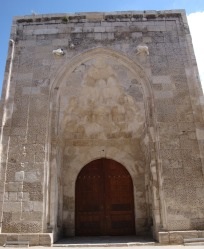 Facing it is the spectacular Çifte Minare (Twin Minaret) Medresesi, built in 1271 by which time the İlkhans had seized power. Their grip on it was soon loosened again by the Selçuks who roared back into town and destroyed all but the elaborate portal, second only to the Gök Medrese or to the Ulu Cami in Divriği for its fantastic stone flourishes.
Facing it is the spectacular Çifte Minare (Twin Minaret) Medresesi, built in 1271 by which time the İlkhans had seized power. Their grip on it was soon loosened again by the Selçuks who roared back into town and destroyed all but the elaborate portal, second only to the Gök Medrese or to the Ulu Cami in Divriği for its fantastic stone flourishes.
The contemporary Bürüciye Medresesi, also in the park, was built to house the tomb of a Persian businessman. These days it serves as a large teahouse ringed with above averagely interesting handicraft shops featuring blown glassware, carved wooden pipes, colourful woollen socks and jewellery using marblework (ebru) designs. Judging by their appearance the columns and capitals of the porticoes that line the medrese must have started life in Sebestea.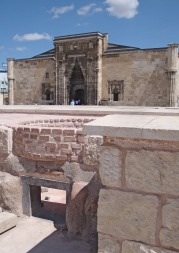
Facing the Buruciye Medresesi across the outlined remains of its hamam, the Kale Camii was built in 1580, by which time the Ottomans were firmly in control.
The builders of the mid-13th century must have been frantically busy, because only a short walk away from the three medreses in the historic park stands the elaborate Gök (Sky Blue) Medrese, another twin-minareted structure that also dates from 1271. Of Sivas’ three contemporary buildings, this is the most impressive because the architect broke with the usual tradition of adorning only the entrance to the medrese and instead made decorative play with the walls as well. An outburst of turquoise tiling on the paired minarets accounts for the building’s colourful name. In 2024 it reopened as a museum after complete restoration.
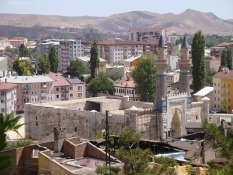 Near the Gök Medrese the Akaylar Konağı is one of Sivas’s finest Ottoman mansions. If you can get to look inside it boasts fine carved wooden ceilings and impressive plasterwork around the niches in the walls.
Near the Gök Medrese the Akaylar Konağı is one of Sivas’s finest Ottoman mansions. If you can get to look inside it boasts fine carved wooden ceilings and impressive plasterwork around the niches in the walls.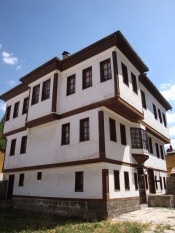
Sivas’ oldest surviving building is the austere Ulu Cami which lurks down Cemal Gürsel Caddesi. Dating back to 1197, it was constructed for the Danışmend sultan Kubbettin Melik Şah and features a forest of stone arches beneath a conspicuously low ceiling. You may find the tall brick minaret more immediately appealing.
With time on your hands you might want to walk east along Atatürk Caddesi until you come to the huge modern Paşa Cami (1980), built, like earlier mosques, above a shopping area. Across the road is the late 19th-century Taş Han (Stone Inn). Continuing east along the road you will come to the Meydan Cami (1564) and the tomb of Şems-i Sivas, a local holy man. The hamam once attached to the mosque is just behind it and still operational. Beyond it look for a small white obelisk (Dikilitaş); keep going north, then turn left to find the stumpy Güdük Minare (Stubby Minaret) and a tomb dating back to the obscure period when Sivas was part of the Eretnid Beylik.
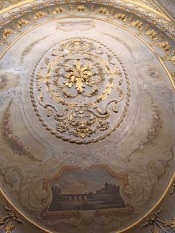 Returning to the landmark Paşa Cami, keep an eye out for the lovely Kangalağa Konağı, a magnificent Ottoman mansion that now houses a restaurant. The top floor has a spectacularly beautiful frescoed ceiling depicting flowers and scenery all picked out with gold-leaf.
Returning to the landmark Paşa Cami, keep an eye out for the lovely Kangalağa Konağı, a magnificent Ottoman mansion that now houses a restaurant. The top floor has a spectacularly beautiful frescoed ceiling depicting flowers and scenery all picked out with gold-leaf.
Walking back to the mosque you should see on your right the late 19th-century stone-built Ziya Bey Library facing the covered market area. Cut south beside the Taş Han until you reach the Yeni Cami (1770). Facing it across the road the newly retored Subaşı Hanı is Sivas’ take on İstanbul’s Spice Market and just as picturesque.
Beside the mosque and also newly restored is an old wooden dervish lodge (dergah) that now houses the Sivas İhramcızade Cultural and Art Centre with lots more handicrafts shops.
Eating
For historic atmosphere head straight for the Kangalağa Konagı. Otherwise try the İnönü Konağı (Tel: 0346-225 6968), a restored Ottoman house associated with Turkey’s second president. It’s out towards the otogar.
Sleeping
Buruciye Otel New hotel in a back street which might make for a quieter night’s sleep. Tel: 0346-222 4020
Büyük Hotel Four-star offering in a high-rise building. Tel: 0346-225 4767
Fatih Otel Cheaper option in the town centre. Tel: 0346-223 4313
Otel Köşk Competing with the Sultan for the three-star business trade. Tel: 0346-225 1724
Sultan Otel. Tel: 0346-221 2986
Transport info
It’s possible to get to Sivas by bus or train from İstanbul or Ankara. Sivas Nuri Demirağ Airport is 20km northwest of town. The high-speed (YHT) train service has reduced travel time from Ankara to just under three hours.
Fewer buses serve the relatively central otogar than you might expect so it’s best to check times before going there.
The terminal for local bus services is right beside the otogar.
Day trip destinations
Sarissa (Kuşaklı)

